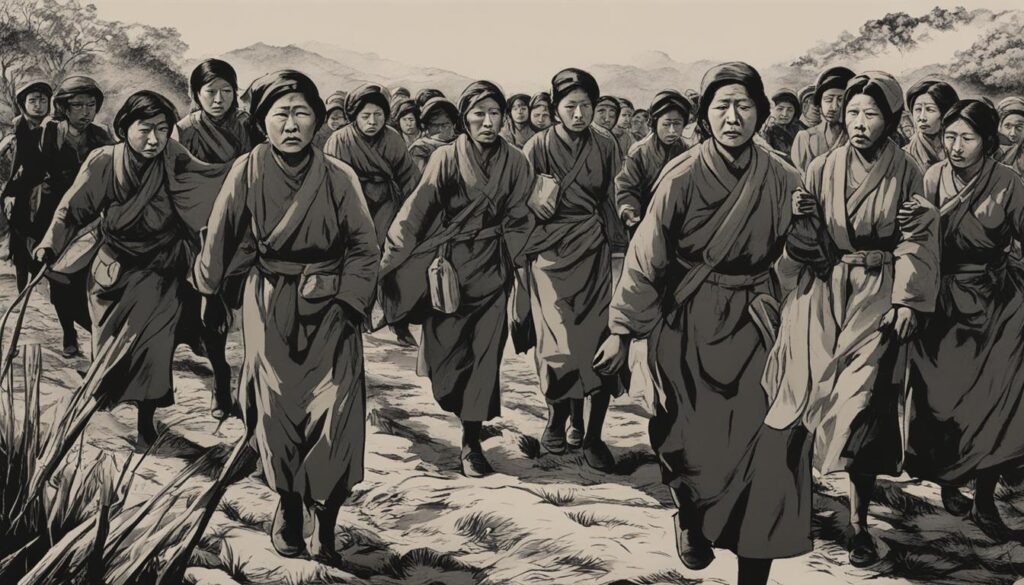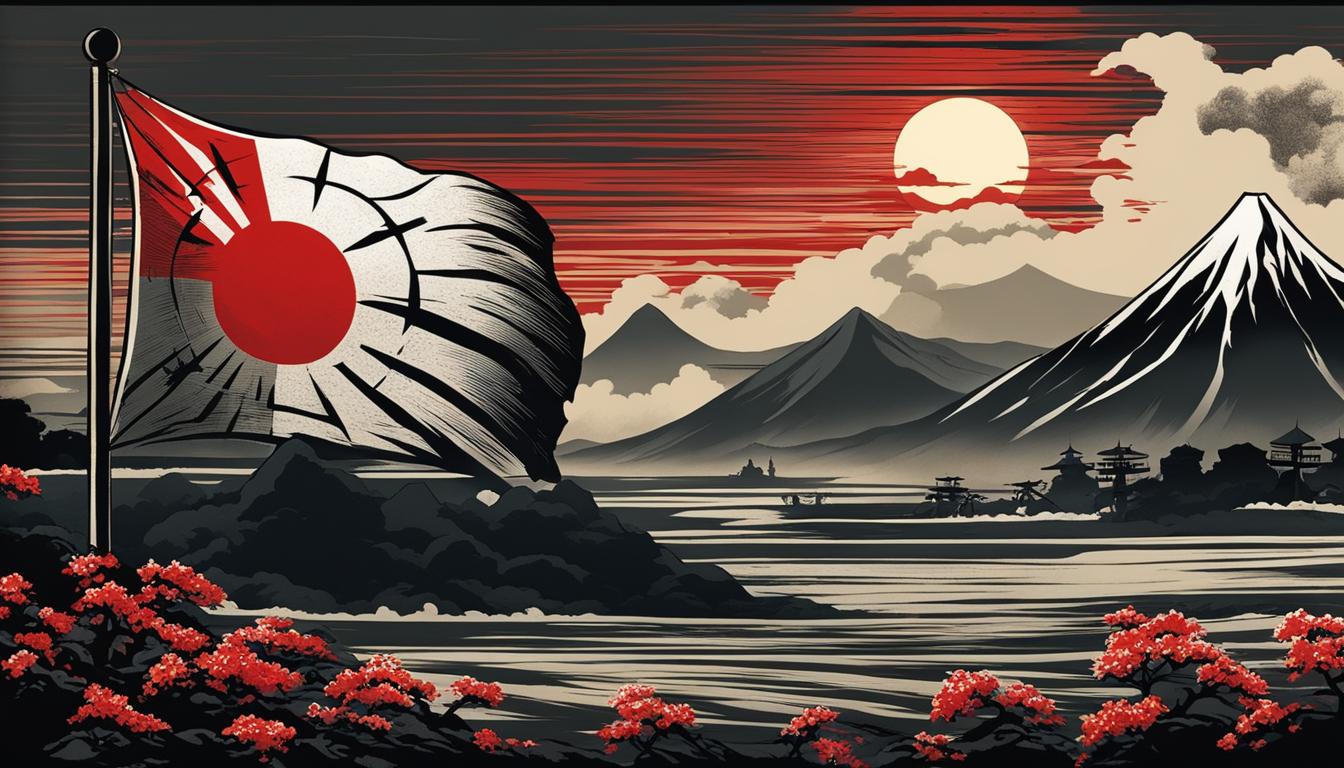Explore the dark and harrowing details of Japan’s actions during World War II in “Horror In The East” by Laurence Rees. Through meticulous chronicling and documentation, this book uncovers the atrocities committed by Japan during this period in human history.
In this section, we provide a comprehensive overview and book summary of “Horror In The East” to give you a glimpse of the detailed and thorough account of Japan’s actions during World War II.
Key Takeaways
- “Horror In The East” by Laurence Rees uncovers the atrocities committed by Japan during World War II.
- Through meticulous documentation, this book provides a detailed account of Japan’s actions during this dark period in human history.
- The book sheds light on the historical context, consequences, and ongoing reflections of Japan’s atrocities.
- Gain insight into the global reactions to Japan’s war crimes and how they have evolved throughout history.
- Remembering and learning from the past events is crucial in building a better future for the world.
Introduction to “Horror In The East”
Written by Laurence Rees, “Horror In The East” sheds light on Japan’s atrocities during World War II. The author meticulously researched and documented the events, providing a clear understanding of the historical context surrounding Japan’s actions and the need to document its atrocities.
Laurence Rees is an acclaimed historian and documentary maker who has specialized in World War II. He is the author of several bestselling books on the subject, including “The Holocaust: A New History” and “Auschwitz: The Nazis and the ‘Final Solution’.” Through “Horror In The East”, Rees expands his body of work to include a detailed account of Japan’s actions during World War II.
Understanding the harrowing events of Japan’s past serves as a reminder of the importance of acknowledging and recording the atrocities committed during wartime. This not only ensures accurate historical documentation but also helps prevent similar tragedies from occurring in the future.
Historical Context of Japan in World War II
The outbreak of World War II in 1939 had a profound impact on the world, including Japan. Imperial Japan was a rapidly industrializing country that sought to expand its influence in Asia, creating a push towards greater militarization and territorial expansion.
Tensions between Japan and the United States had also been building up, particularly in the Pacific region. The United States restricted Japan’s access to vital natural resources and oil, which Japan depended on for economic growth and military expansion.
Frustrated with the United States’ embargo, Imperial Japan launched a surprise attack on Pearl Harbor on December 7, 1941, drawing the U.S. into World War II. Japan’s subsequent involvement in the Pacific War marked a turning point in the conflict, with Japan eventually surrendering in August 1945 after years of bloody and devastating battles.

The historical context surrounding Japan’s involvement in World War II helps shed light on the country’s decision-making processes and its ultimate choices. It also highlights the impact of global power struggles and their devastating consequences.
Prelude to Atrocities: Japanese Expansionism
Japan’s leadership, under Emperor Hirohito, pursued a policy of expansionism during World War II. One of its key visions was the establishment of the Greater East Asia Co-Prosperity Sphere, a new world order under Japanese domination. The Sphere’s concept aimed to create an economic and political bloc in which Japan could extract raw materials and sell Japan-made products. This expansionist policy led to the occupation of numerous countries in Asia and the Pacific, including Korea, China, and the Philippines.
However, Japan’s aggression was not limited to economic expansion. One of the most notorious events associated with Japan’s expansion was the Nanking Massacre of 1937. After capturing the city of Nanking (modern-day Nanjing), the Japanese army proceeded to rape, murder, and torture tens of thousands of Chinese civilians and prisoners of war. The incident remains a stain on Japan’s modern history and highlighted the extreme brutality that Japanese troops were willing to wield.
Japanese Expansion and the Conquest of Asia and the Pacific
| Country/Region | Date of Conquest | Main Atrocities Committed |
|---|---|---|
| Korea | 1910 | Forced assimilation, exploitation, war crimes |
| China | 1931-1945 | Nanking Massacre, comfort women, biological warfare, forced labor |
| Philippines | 1941-1945 | Manila Massacre, Bataan Death March |
| Indonesia | 1942-1945 | Forced labor, massacre of Chinese Indonesians |
The Greater East Asia Co-Prosperity Sphere and the Nanking Massacre demonstrate Japan’s willingness to inflict untold horrors in pursuit of its expansionist agenda. These events set the stage for later atrocities committed by the Japanese military and highlight the need to remember these tragedies in the ongoing pursuit of peace and education.
Documentation of Japanese War Crimes
Japan’s gruesome atrocities during World War II are well-documented, revealing the depravity of their war machine. One such program was Unit 731, a covert biological and chemical warfare research unit. In the name of science, human subjects were vivisected without anesthesia and exposed to diseases and toxins, resulting in countless deaths and unimaginable suffering.
The suffering of comfort women is another dark stain in Japan’s wartime past. Women from occupied territories were forced into sexual slavery by the Japanese military, with estimates putting the number of victims as high as 200,000. These women were subjected to rape, torture, and forced abortions, with many dying or suffering life-long physical and psychological trauma.
The Bataan Death March is yet another example of Japan’s barbaric treatment of prisoners of war. Following their capture in the Philippines, American and Filipino prisoners were subjected to a grueling forced march to a prison camp. Those who stumbled or fell from exhaustion were beaten, bayoneted, or shot. Thousands perished on the march, with overall estimates of deaths ranging from 5,000 to 18,000.

Unit 731’s Experiments on Human Subjects
| Test | Method | Outcome |
|---|---|---|
| Vivisection | Surgeons cut open patients without anesthesia, sometimes while they were still alive | Countless deaths and unfathomable suffering |
| Testing of Biological Agents | Humans were exposed to diseases such as anthrax and plague | Results used for military purposes, no medical value |
Comfort Women’s Plight
- Women from various countries were forcibly taken to Japanese military brothels
- Many women were repeatedly raped every day and suffered long-lasting physical and psychological trauma
- Japan has been criticized for denying responsibility and for its handling of the issue in the post-war period
The Brutality of the Bataan Death March
Following their capture in the Philippines, prisoners of war were forced to march roughly 100 km to reach their destination. Many prisoners were severely beaten, shot, or bayoneted by their captors, with little to no medical treatment available. The death toll varied widely, with estimates ranging from 5,000 to 18,000.
Despite these horrific events, Japan’s wartime conduct remained shrouded in secrecy for years after the end of the war. It was only through the tireless efforts of historians and survivors that the full extent of Japan’s atrocities were brought to light.
Repercussions and Aftermath of Japan’s Atrocities
Japan’s brutal conduct during World War II had far-reaching consequences. In the aftermath of the war, the international community and Japan faced the daunting challenge of holding war criminals accountable, dealing with war reparations, and fostering post-war reconciliation.
One of the significant outcomes of Japan’s war crimes was the Tokyo Trials, held from 1946 to 1948. The trials saw the prosecution of 25 senior Japanese leaders for their roles in planning and executing war crimes. The trials resulted in several convictions, including seven death sentences.
The issue of war reparations was also a critical concern in the aftermath of World War II. Japan was left devastated, and its economy in shambles, prompting a demand for reparations by the countries affected by Japan’s aggression. In 1951, Japan signed the San Francisco Peace Treaty, agreeing to pay war reparations. The treaty marked Japan’s return to the international community and ushered in a period of post-war reconstruction and economic revival.
The process of post-war reconciliation, however, was far more complex and challenging. The scars inflicted by Japan’s atrocities ran deep, and many victims and their families found it difficult to forgive and forget. Japan was also grappling with the task of coming to terms with its past, acknowledging its culpability, and making amends.
Today, Japan has made significant efforts towards post-war reconciliation, acknowledging and apologizing for its wartime conduct. The country has established various initiatives to preserve the memory of the atrocities committed during World War II, promote reconciliation, and foster international relations.
Global Reactions and Historical Reflections
The international response to Japan’s war crimes during World War II was swift and far-reaching. The atrocities committed by Japan, including the Nanking Massacre and the use of comfort women, were met with outrage and condemnation from around the world. Countries like the United States, the United Kingdom, Australia, and China demanded justice and accountability for Japan’s war crimes.
Historians have subsequently examined Japan’s wartime conduct through the lens of historiography, with different interpretations and perspectives emerging over time. The early research presented Japan as a victim of aggression, while later works exposed the full extent of Japan’s atrocities.
Revisionist narratives challenging the dominant historical discourse have also emerged, downplaying or denying Japan’s role in the atrocities committed during World War II. This has sparked heated debates and controversy in academic circles and beyond, with some suggesting that these narratives are an attempt to rewrite history and revise the historical record.
International Responses to Japan’s War Crimes
| Country | Response |
|---|---|
| United States | Established War Crimes Tribunals to try Japanese war criminals |
| United Kingdom | Conducted investigations into Japanese war crimes, demanded accountability |
| Australia | Demanded the prosecution of Japanese war criminals |
| China | Documented Japanese war crimes, demanded justice and reparations |
In conclusion, the global response to Japan’s war crimes during World War II was a crucial chapter in the history of accountability for war crimes. The emergence of historiography and revisionist narratives has provided valuable insights into the significance and complexity of this historical period. To ensure that we learn from the past and prevent such atrocities from occurring in the future, it is crucial to continue exploring and reflecting on this dark chapter of human history.
Legacy and Lessons Learned
Japan’s atrocities during World War II were some of the most heinous acts committed in modern history. As we look back on this dark period, we must remember the lessons learned and the importance of war crimes education, remembrance ceremonies, and the role of collective memory in ensuring that these atrocities never happen again.
War crimes education is a crucial element in addressing the legacy of Japan’s atrocities. By teaching future generations about the horrors of war, we can ensure that history does not repeat itself. Through education, we can encourage empathy and promote peace, fostering a better understanding of the consequences of violent conflict.
Remembrance ceremonies play a vital role in ensuring that the victims of Japan’s wartime atrocities are not forgotten. By coming together to mourn and pay tribute to those who suffered, we honor their memory and ensure that their sacrifice is not in vain. The annual commemorative events held in Japan and other countries serve as a reminder of the atrocities committed in the past and the need to build a better future.
Collective memory is essential in shaping society’s understanding of history and ensuring that the lessons learned are not forgotten. By preserving historical documents and artifacts, we can ensure the horrors of World War II are not overlooked or sugar-coated. The collective memory of past atrocities also serves as a deterrent for future generations, limiting the possibility of such actions happening again.
Examples of War Crimes Education and Remembrance Ceremonies
| Event | Date | Location |
|---|---|---|
| The Nanking Massacre Memorial Day | December 13th | Nanjing, China |
| International Day of Reflection on the 1994 Genocide against the Tutsi | April 7th | United Nations |
| Yasukuni Shrine | Annually on August 15th | Tokyo, Japan |
| Treaty of Versailles Centenary | June 28th, 2019 | France |
Overall, the legacy of Japan’s wartime atrocities serves as a stark reminder of the extent of human cruelty and the importance of learning from history. Through war crimes education, remembrance ceremonies, and collective memory, we can ensure that such atrocities never happen again.
Conclusion
Laurence Rees’ “Horror In The East” provides a comprehensive and meticulous chronicle of Japan’s atrocities during World War II. From the establishment of the Greater East Asia Co-Prosperity Sphere to the Nanking Massacre, and the brutality of Unit 731 and the Bataan Death March, Rees documents the harrowing events of this dark period in human history.
The book also explores the repercussions and aftermath of Japan’s actions, including the Tokyo Trials and the issue of war reparations. It analyzes the global reactions and subsequent examination by historians, including the emergence of revisionist narratives.
Importantly, the lasting legacy of Japan’s atrocities is also examined. Rees highlights the significance of remembering and learning from history through war crimes education, remembrance ceremonies, and the role of collective memory in today’s society.
In conclusion, “Horror In The East” provides valuable insights into the historical context, consequences, and ongoing reflections of Japan’s atrocities during World War II. It is a must-read for those seeking a deeper understanding of this tragic chapter in human history.



